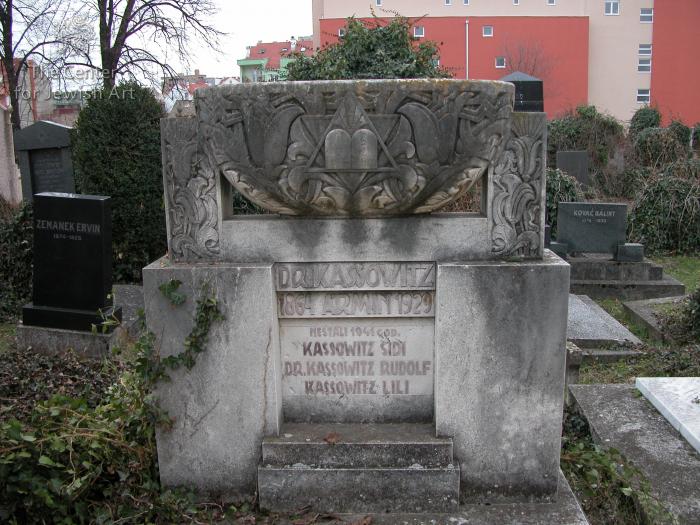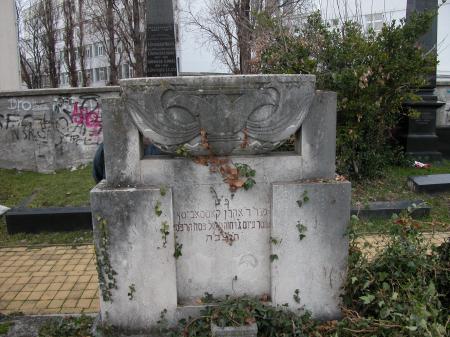Obj. ID: 50020
Jewish Funerary Art Kassowitz Family Grave in the Jewish cemetery in Novi Sad, Serbia
To the main object: Jewish cemetery in Novi Sad, Serbia

Memorial Name
No official name
Who is Commemorated?
Members of the Kassowitz Family killed in the Holocaust
Description
The tomb of Dr. Ármin Aharon Kassowitz (1864-1929), is made of worked stone and designed in the style of the Hungarian secession; a tall base surrounded with two columns features the epitaph of Dr. Kassowitz in Hungarian, and the inscription in Serbo-Croatian added after the war with the names of Armin's wife Sidi, his son Rudolf and his wife Lili. The top part of the tomb has a semicircular shape set on two columns. The top section is elaborately carved with delicate floral motifs bearing some traditional Jewish symbols: a Magen David, the Tablets of the Law, and an image of a lily. On the back side is an epitaph of Dr. Kassowitz written in Hebrew. The epitaph incorporates the Hebrew name of the deceased (Aharon), his father’s name (Mór), and the Hebrew date of his death.
Inscriptions
Front Inscription (Hungarian)
Dr. Kassowitz
1864 Ármin 1929
Nestali 1941 god.
Kassowitz Sidi
Dr. Kassowitz Rudolf
Kassowitz Lili
Translation: Dr. Kassowitz / 1864 Ármin [Dr. Kassowitz's first name] 1929 // Disappeared in 1941 / Kassowitz Sidi / Dr. Kassowitz Rudolf / Kassowitz Lili
Back Inscription (Hebrew)
פ"נ
מור ר' אהרן קאסאביטז
נפטר ביום ג' דחוה משל פסח התרפ"ט
תנצבה
Translation: Here lies Mor R. Aharon Kassowitz. He passed away on the third day of Passover 5689. May his soul be bound in the bundle of life
Commissioned by
Surviving members of the Kassowitz Family
sub-set tree:
Dr. Ármin Aharon Kassowitz (1864-1929), was a dentist and a two-term president of the Jewish community, between 1910 and 1912, and in 1925. After the war, the names of his wife Sidi, their son Rudolf and his wife Lili were added.
According to some sources, Dr. Rudolf Kassowitz (1893-1944), a dental practitioner, was killed in 1944 in the Dachau camp, while according to others, he was sent to Auschwitz on November 1, 1944, passed the selection, and was murdered afterward. Lili Kassowitz nee Friedman (1900-1944) and Sidi Kassowitz nee Kohn (1874-1944) perished in Auschwitz. We do not know for sure who added the inscription; however, we know that the daughter of Rudolf and Lili, Eva, survived the Holocaust as well as two daughters of Ármin's brother Max, thus some of them possibly added the commemorative inscription to the perished family members.
Information on the Kassowitz family members and their fate during the Holocaust can be found on the website vojvodinakom1941.org on the Wayback Machine and in the Central Database of Shoah Victims' Names on the Yad Vashem's website.
Michael Kara, the Jewish Hungarian sculptor, who designed the headstone, was born in 1885 in Berezhany, then part of the Austro-Hungarian Empire. Kara, whose original family name was Krón, initially lived and created in Budapest. Stemming from an acculturated family and developing as an artist along with his two brothers, Jenő and Béla, who chose the same profession, Kara experienced early success in both official and avant-garde circles, eventually changing his family name from Krón into the less-Jewish-sounding Kara.
However, at the end of World War I, with the collapse of Béla Kun’s short-lived Soviet Republic established on the ruins of the Dual Monarchy, Kara, as an outspoken leftist and ardent supporter of the revolution, had to escape and found his way to Oradea, Romania. Notwithstanding the circumstances, in Romania, he quickly landed on his feet and established himself once again as a successful artist creating monumental sculptures for the Romanian royal family. With the rise of anti-Semitism in Romania, however, he decided in 1928 to move again, this time to Novi Sad, Yugoslavia. Only six years after his arrival in Novi Sad, and due to growing animosity toward foreigners in pre-World War II Yugoslavia, the “non-resident” Kara had to leave once more.
In 1935 the artist arrived in Italy where, living as an émigré in Milan and later in hiding in Bergamo, he found refuge during World War II. Finally, shortly after the liberation in 1945, Kara immigrated to Palestine and settled in Tel Aviv, where he spent the last eighteen years of his life, continuing his career as a sculptor of public memorials and a painter.
"Memorials in Novi Sad," Locations (Vojvodina Holocaust Memorials Project), https://www.vhmproject.org/en-US/Locations/Memorials/17 (accessed April 10, 2022)
Ungar, Olga. “Navigating Between the Intimate and the Public: Hungarian Jewish Sculptor Michael Kara, Commissions for Jewish Institutions and Individuals in Yugoslavia and His Reception in Israel.” in Always Hungarian: The Jews of Hungary through the Vicissitudes of the Modern Era, ed. Anna Szalai et al., (Bar Ilan Univ, pp. 205-238.




